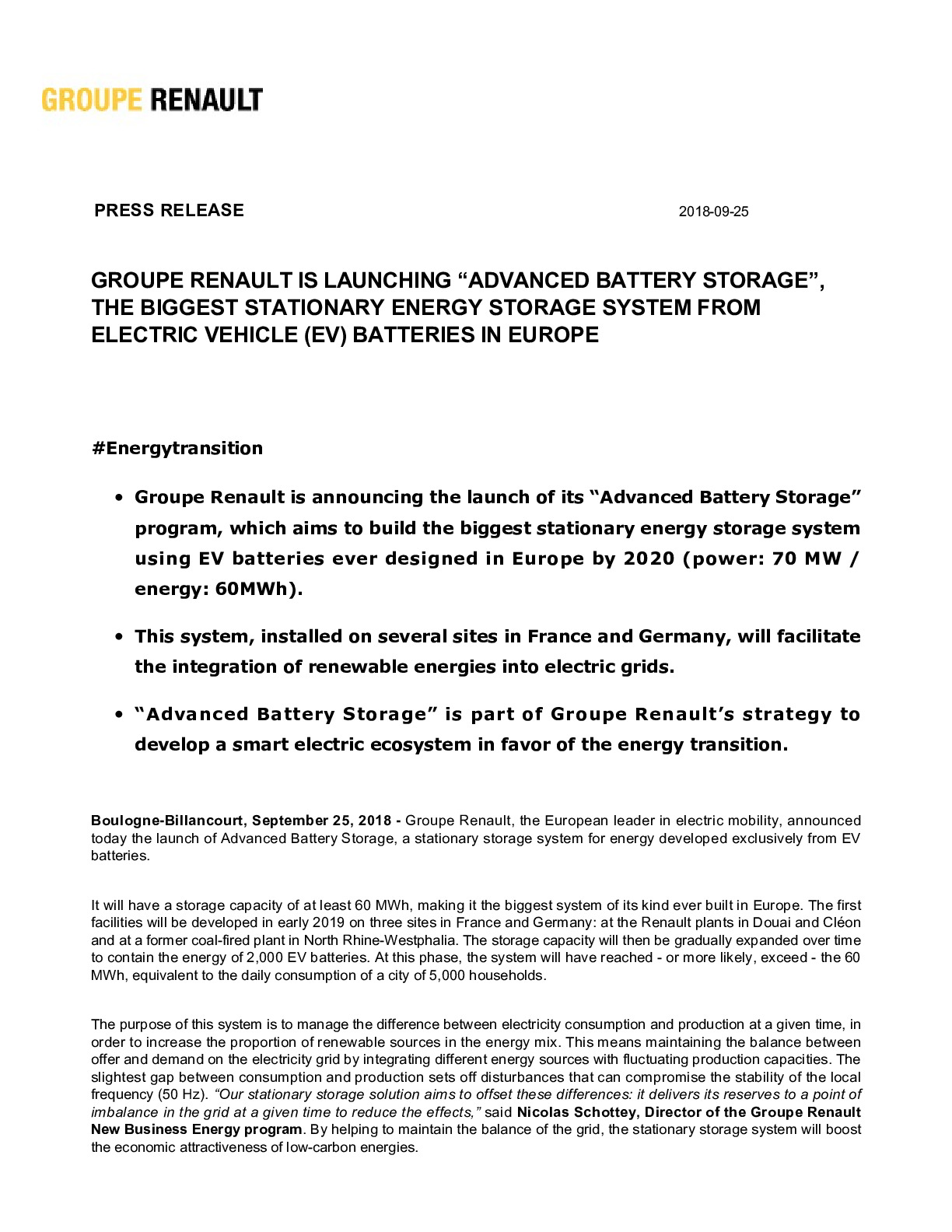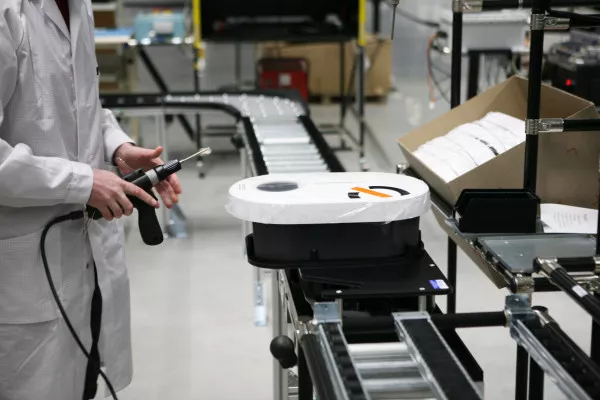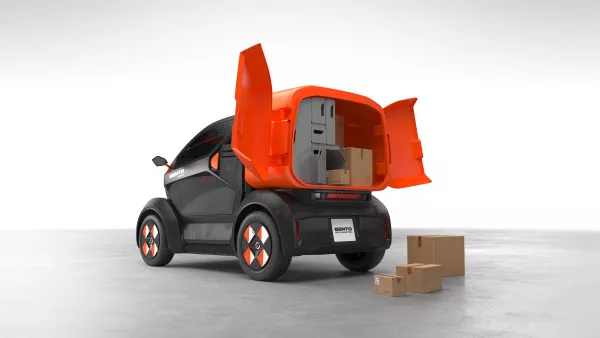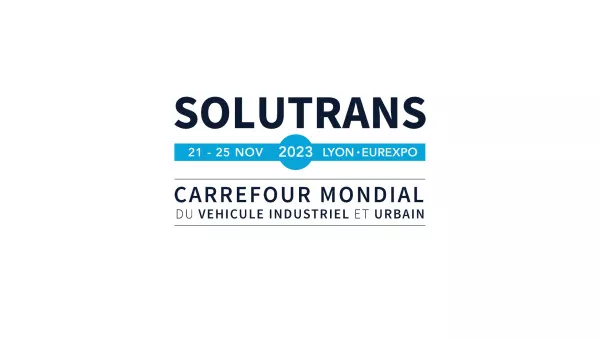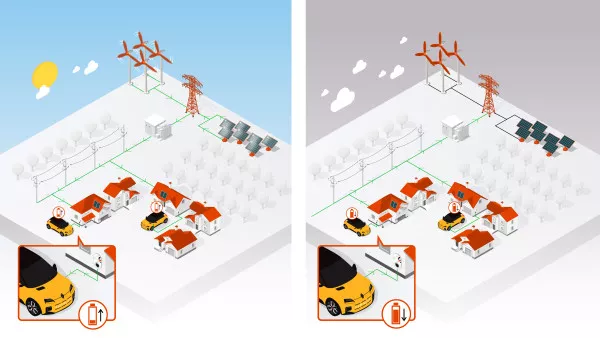Groupe Renault is launching “Advanced Battery Storage”, the biggest stationary energy storage system from electric vehicle (EV) batteries in Europe
#Energytransition
- Groupe Renault is announcing the launch of its “Advanced Battery Storage” program, which aims to build the biggest stationary energy storage system using EV batteries ever designed in Europe by 2020 (power: 70 MW / energy: 60MWh).
- This system, installed on several sites in France and Germany, will facilitate the integration of renewable energies into electric grids.
- “Advanced Battery Storage” is part of Groupe Renault’s strategy to develop a smart electric ecosystem in favor of the energy transition.
Le 25 September 2018
Boulogne-Billancourt, September 25, 2018 - Groupe Renault, the European leader in electric mobility, announced today the launch of Advanced Battery Storage, a stationary storage system for energy developed exclusively from EV batteries.
It will have a storage capacity of at least 60 MWh, making it the biggest system of its kind ever built in Europe. The first facilities will be developed in early 2019 on three sites in France and Germany: at the Renault plants in Douai and Cléon and at a former coal-fired plant in North Rhine-Westphalia. The storage capacity will then be gradually expanded over time to contain the energy of 2,000 EV batteries. At this phase, the system will have reached - or more likely, exceed - the 60 MWh, equivalent to the daily consumption of a city of 5,000 households.
The purpose of this system is to manage the difference between electricity consumption and production at a given time, in order to increase the proportion of renewable sources in the energy mix. This means maintaining the balance between offer and demand on the electricity grid by integrating different energy sources with fluctuating production capacities. The slightest gap between consumption and production sets off disturbances that can compromise the stability of the local frequency (50 Hz). “Our stationary storage solution aims to offset these differences: it delivers its reserves to a point of imbalance in the grid at a given time to reduce the effects,” said Nicolas Schottey, Director of the Groupe Renault New Business Energy program . By helping to maintain the balance of the grid, the stationary storage system will boost the economic attractiveness of low-carbon energies.
This stationary storage system is built using EV batteries compiled in containers. The system uses second-life batteries, as well as new batteries stored for future use in standard replacement during after-sales operations. “This unique assembly will give Advanced Battery Storage the capacity to generate or absorb, instantaneously the 70MW power. This high power combined with high capacity of our solution will allow to react efficiently to all major grid solicitations”, explains Nicolas Schottey .
Close collaboration with our partners
As the pioneer and leader in the field of electric mobility in Europe, Groupe Renault is extending beyond its role as a vehicle manufacturer to become a player in the smart electric and energy ecosystems, with the help of its partners. As part of the “Advanced Battery Storage” program, Groupe Renault has joined up with several players including La Banque des Territoires, the Mitsui Group, Demeter (via le Fonds de Modernisation Ecologique des Transports), and The Mobility House.
More information about Renault’s commitment to electric mobility: EasyElectricLife
|
About the smart electric ecosystem
|
About Groupe Renault
Groupe Renault, which has been making cars since 1898, is now an international corporation with a presence in 134 countries and sales of 3.76 million vehicles in 2017. Today, the company has over 180,000 employees, 36 manufacturing sites and 12,700 sales outlets worldwide. To meet the major technological challenges of the future while continuing to pursue its profitable growth strategy, the Renault group is focusing on international expansion. To this end, it is drawing on the synergies of its five brands (Renault, Dacia, Renault Samsung Motors, Alpine and LADA), electric vehicles, and its unique alliance with Nissan and Mitsubishi. With its Formula 1 racing team, Renault is leveraging motorsports to drive innovation and boost brand awareness.
sur le même sujet



